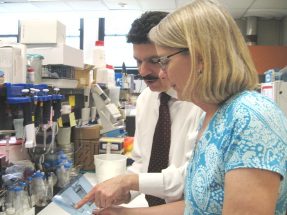 What began as a summer project in 2000 changed the lives of Dr. Rubin and Dr. Anderson, as well as so many all over the world. For many years, these researchers worked in the fields of immunology and cancer. They were successful. They had consistently received funding from the National Institutes of Health, they had published numerous articles in top-tier journals and they were invited, on a regular basis, to present their research findings at national and international scientific conferences. Dr. Rubin was invited to deliver a seminar at a joint plenary session held by the American Association of Cancer Research and the American Society of Clinical Oncologists. Several thousand cancer researchers and physicians attended his lecture. Dr. Rubin served for many years as an Associate Editor for the journal, Cancer Research.
What began as a summer project in 2000 changed the lives of Dr. Rubin and Dr. Anderson, as well as so many all over the world. For many years, these researchers worked in the fields of immunology and cancer. They were successful. They had consistently received funding from the National Institutes of Health, they had published numerous articles in top-tier journals and they were invited, on a regular basis, to present their research findings at national and international scientific conferences. Dr. Rubin was invited to deliver a seminar at a joint plenary session held by the American Association of Cancer Research and the American Society of Clinical Oncologists. Several thousand cancer researchers and physicians attended his lecture. Dr. Rubin served for many years as an Associate Editor for the journal, Cancer Research.
In spite of their long track record and all of their successes, Drs. Rubin and Anderson did the unthinkable. They abandoned their research program and began a new program in a completely different scientific field. Few have attempted such change and even fewer have succeeded. This change began with what was to be a “short break” from their research program. They had decided to spend a few months working on a project that would help the Ashkenazi Jewish community. A genetic disease known as Familial Dysautonomia (FD) was known to exist in this population, but the disease-causing mutation had yet to be identified. Couples would find out that they were carrying the FD-causing mutation when they would have a child with the disorder. While a genetic test was available for many other Jewish genetic diseases present in this population, no such test existed for FD, because the causative mutation had not been identified. Other research teams had endeavored to identify the disease-causing mutation, but they had not been successful.
In the summer of 2000, Dr. Rubin and Dr. Anderson decided to search for the FD-causing mutation. The scientific approach they undertook was unique and with the many talented students who worked in their lab, approximately three months after initiating the project, they found the disease-causing mutation in a gene known as IKBKAP (now known as ELP1). This information was published shortly after the discovery and genetic screening programs were quickly established. As these researchers began to transition back to their immunology and cancer research programs, a few things happened that changed their plans. Families with children who had FD came to visit their lab to express their gratitude for what they had accomplished. During these meetings, Drs. Rubin and Anderson met many children with FD. As Dr. Anderson puts it, “These children were such personable, intelligent, charming individuals who were facing life-threatening medical challenges. It was so painful to see how hard they struggled just to get through the day.” And then in May of 2001, an 11-year old child with FD passed away. This death had a profound effect on these researchers. They realized that their discovery of the mutation that causes FD meant that, with time, no more children would be born with this disease and, as a result, it was unlikely that much scientific effort would be expended to help the children who already had FD. Their scientific discovery provided an incredible benefit to the Ashkenazi Jewish population and, at the same time, likely ensured that the children living with FD would be ignored by the scientific community. For these researchers, this comprehension represented a very painful realization.
During their initial studies of the FD-causing mutation, Drs. Rubin and Anderson observed that this mutation did not completely eliminate the ability of the cells of an FD patient to produce the functional IKBKAP (now known as ELP1) gene product. While most of the gene product produced in these cells was defective, the cells did produce a small amount of the functional product. They wondered whether treatments could be developed that would facilitate the production of the functional gene product in individuals with FD. After much soul-searching, they decided to shift their research focus and work on the identification of chemical compounds that could increase the production of the functional IKBKAP (now known as ELP1) gene product.
Before commencing this research program, they established and committed to paper the following guiding principles:
- They should cause no harm to this patient population; in other words, any proposed treatments should be as non-toxic as possible, with as few side effects as possible.
- There should be no financial or regulatory barriers to the use of any of the therapeutic compounds that they identify.
- All findings that can benefit those with FD should be shared with this community as quickly as possible.
In 2001, Drs. Rubin and Anderson began their search for compounds with therapeutic potential. They analyzed and studied the effect of commonly consumed compounds that were readily available to the FD patient population. Their first discovery, which was published in 2003, demonstrated that a form of vitamin E (known as tocotrienols), that is present in brown rice, increases the production of the functional IKBKAP (now known as ELP1) gene product. This compound, which is heavily consumed by Asian populations and has been reported to have many health benefits, was readily available to the FD population and the cost of this compound was very reasonable. Its use by those with FD began almost immediately after the results were published. Since that time, numerous articles have been published in the scientific literature that confirm the positive impact of the ingestion of tocotrienols on individuals with FD.
Drs. Anderson and Rubin continued their search for therapeutic compounds and a few months later, they published a scientific article that demonstrated that epigallocatechin gallate (EGCG), a compound present in green tea, increases the production of the functional IKBKAP (now known as ELP1) gene product. Several years later, they found that the ingestion of Vitamin A and beta-carotene also increased the production of this gene product. This research effort has continued and, in 2012, they demonstrated that the combined treatment of EGCG and genistein, a compound present in soy beans, results in the production of normal levels of the IKBKAP (now known as ELP1) gene product. These researchers accomplished for those with FD what no other research teams have been able to achieve for any other population of individuals with a genetic disorder. They have successfully addressed the impact of a genetic mutation on a molecular level with easily accessible compounds that are safe to use. For the cost of a few hundred dollars per year, a child with FD can lead a much healthier life!
While their research findings significantly improved the lives of those with FD, Drs. Rubin and Anderson noted that some with FD were still experiencing hypertensive crises. As these crises could be life-threatening, they focused their energy on developing a clear scientific understanding of the underlying cause of these hypertensive events. Their research has led to discoveries that have revolutionized the care and treatment of individuals with FD. They discovered that individuals with FD have a reduced level of an enzyme known as monoamine oxidase A and it is the reduced presence of this enzyme that is the cause of the sensitivity of those with FD to certain foods and medications. This understanding has allowed for a change in diet and in the use of medications such that individuals with FD can avoid hypertensive crises. Children who for their entire lives had crises once or twice per week have, as a result of these findings, not had a crisis in years!
These two researchers have spent nearly two decades studying FD and their work has transformed the lives of those with this disease. During this period, they published numerous peer-reviewed scientific articles that have elucidated the therapeutic benefits of a variety of commonly available nutraceuticals for those with FD and have provided new insight into the pathophysiology of the disease. Dr. Anderson and Dr. Rubin are grateful for the opportunity to change this disorder from a life-threatening acute disease for all who have it to one that is far more manageable. They are thrilled to attend weddings, Bar/Bas Mitzvahs and graduations of the children and adults with FD and are pleased to see that their research program has had a profound positive impact on the lives of so many. Yet they don’t spend much time thinking about their successes – they think about what still needs to be accomplished and there is an urgency in their efforts.
